The NVIDIA GeForce GTX 780 Ti Review
by Ryan Smith on November 7, 2013 9:01 AM ESTOverclocking
Finally, let’s spend a bit of time looking at the overclocking prospects for the GTX 780 Ti. Although GTX 780 Ti is now the fastest GK110 part, based on what we've seen with GTX 780 and GTX Titan there should still be some headroom to play with. Meanwhile there will also be the matter of memory overclocking, as 7GHz GDDR5 on a 384-bit bus presents us with a new baseline that we haven't seen before.
| GeForce GTX 780 Ti Overclocking | ||||
| Stock | Overclocked | |||
| Core Clock | 876MHz | 1026MHz | ||
| Boost Clock | 928MHz | 1078MHz | ||
| Max Boost Clock | 1020MHz | 1169MHz | ||
| Memory Clock | 7GHz | 7.6GHz | ||
| Max Voltage | 1.187v | 1.187v | ||
Overall our overclock for the GTX 780 Ti is a bit on the low side compared to the other GTX 780 cards we’ve seen in the past, but not immensely so. With a GPU overclock of 150MHz, we’re able to push the base clock and maximum boost clocks ahead by 17% and 14% respectively, which should further extend NVIDIA’s performance lead by a similar amount.
Meanwhile the inability to unlock a higher boost bin through overvolting is somewhat disappointing, as this is the first time we’ve seen this happen. To be clear here GTX 780 Ti does support overvolting – our card offers up to another 75mV of voltage – however on closer examination our card doesn’t have a higher bin within reach; 75mV isn’t enough to reach the next validated bin. Apparently this is something that can happen with the way NVIDIA bins their chips and implements overvolting, though this the first time we’ve seen a card actually suffer from this. The end result is that it limits our ability to boost at the highest bins, as we’d normally have a bin or two unlocked to further increase the maximum boost clock.
As for memory overclocking, we were able to squeeze out a bit more out of our 7GHz GDDR5, pushing our memory clock 600MHz (9%) higher to 7.6GHz. Memory overclocking is always something of a roll of the dice, so it’s not clear here whether this is average or not for a GK110 setup with 7GHz GDDR5. Given the general drawbacks of a wider memory bus we wouldn’t be surprised if this was average, but at the same time in practice GK110 cards haven’t shown themselves to be as memory bandwidth limited as GK104 cards. So 9%, though a smaller gain than what we’ve seen on other cards, should still provide GTX 780 Ti with enough to keep the overclocked GPU well fed.
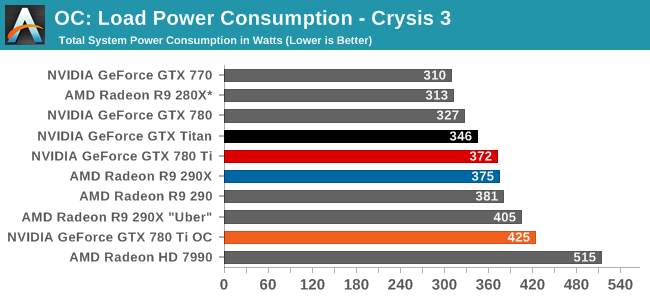
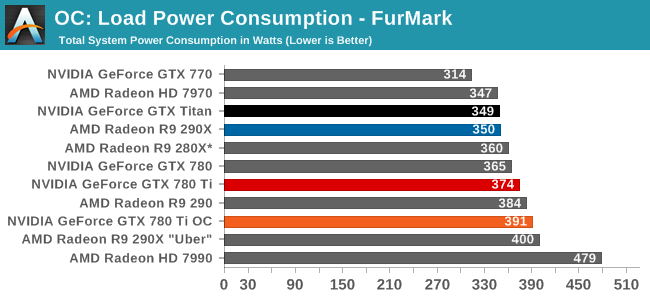
Starting as always with power, temperatures, and noise, we can see that overclocking GTX 780 Ti further increases its power consumption, and to roughly the same degree as what we’ve seen with GTX 780 and GTX Titan in the past. With a maximum TDP of just 106% (265W) the change isn’t so much that the card’s power limit has been significantly lifted – as indicated by FurMark – but rather raising the temperature limit virtually eliminates temperature throttling and as such allows the card to more frequently stay at its highest, most power hungry boost bins.
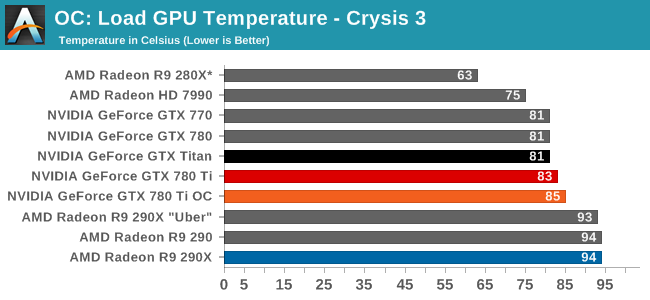

Despite the 95C temperature target we use for overclocking, the GTX 780 Ti finds its new equilibrium point at 85C. The fan will ramp up long before it allows us to get into the 90s.
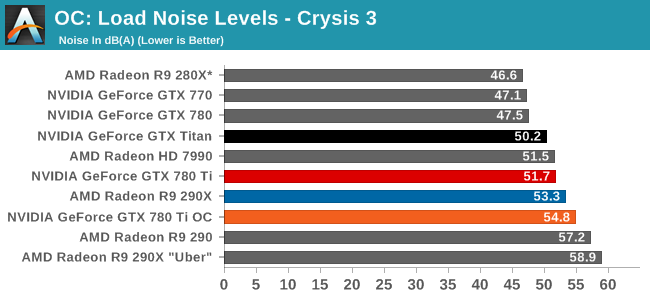
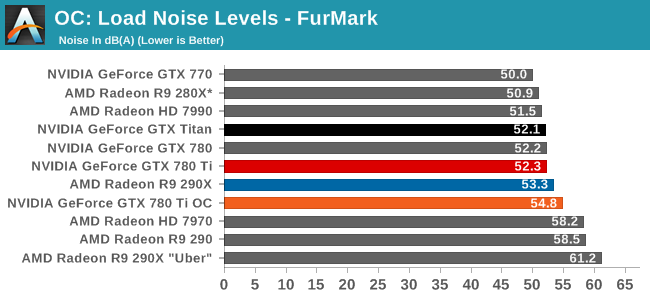
Given the power jump we saw with Crysis 3 the noise ramp up is surprisingly decent. A 3dB rise in noise is going to be noticeable, but even in these overclocked conditions it will avoid being an ear splitting change. To that end overclocking means we’re getting off of GK110’s standard noise efficiency curve just as it does for power, so the cost will almost always outpace the payoff on a relative basis.
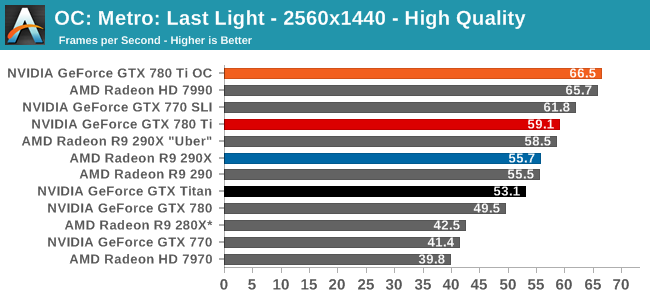
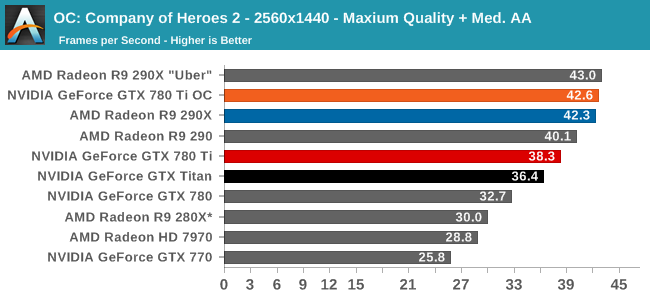
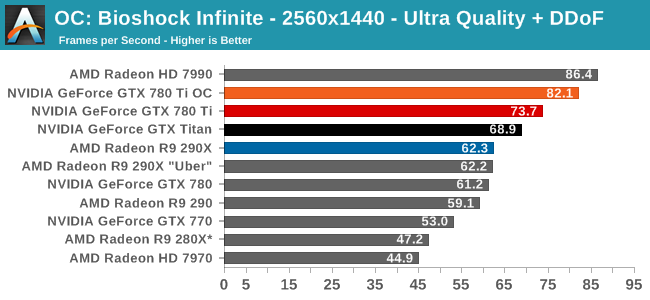
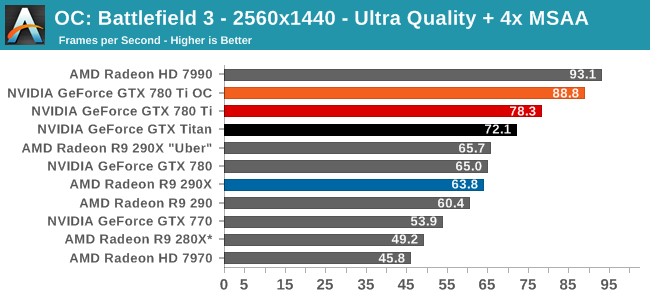
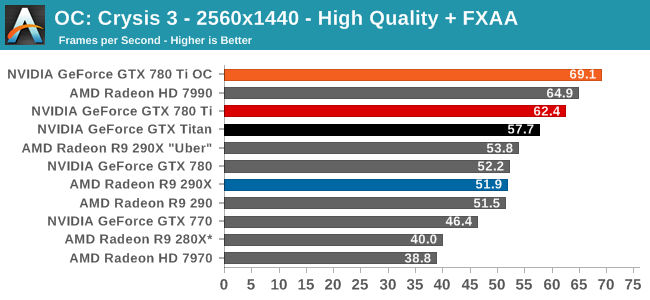
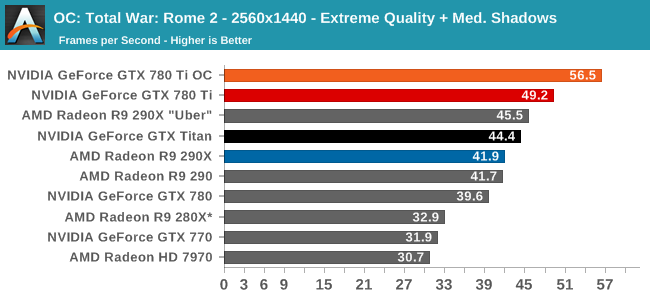
Finally, looking at gaming performance the the overall performance gains for overclocking are generally consistent. Between our 6 games we see a 10-14% performance increase, all in excess of the memory overclock and closely tracking the GPU overclock. GTX 780 Ti is already the fastest single-GPU card, so this only further improves its performance lead. But it does so while cutting into whatever is above it, be it the games where the stock 290X has a lead, or multi-GPU setups such as the 7990.










302 Comments
View All Comments
Owls - Thursday, November 7, 2013 - link
Ryan I'm sorry but the video card reviews as of late have been very poor in quality and objectivity. Stop rushing to be the first. I don't go to Anand to read a crappy review, that's what HardOCP is for.That said your testing is flawed with old games and comparing the Ti to be faster than a 290x that is in silent mode is disingenuous. We all expect better from this site.
nsiboro - Friday, November 8, 2013 - link
True - unfortunate wordings. But we gotta learn to read between the lines e.g. 780ti cannot be compared to 290/X. :)nunomoreira10 - Thursday, November 7, 2013 - link
totallywhy does he even compare the non "uber" 290x to the 780TI
its very misleading when he says it´s 11% faster then 290x not pointing out the fact that it was in silent mode.
also not sure which drivers were used on the 290x
hoboville - Thursday, November 7, 2013 - link
Sigh, I've always had good experiences with Nvidia products. They have always been good to me, but the pricing nonsense of GK110 has really put me off, a lot. I get it, you have the best so you charge people for the best, but all this does is put performance hardware further out of reach of people.Most people can't afford even $300 GPUs. A fact Maximum PC editors have commented on many times when they talk about how most people have relatively "low-end" hardware in their systems. AMD, because they haven't had the performance crown has clearly been going for performance-per-dollar. And that's good, very good for you. Because let's face it, money is a real determining factor for almost everyone.
And to think, if I did have $700 to spend, I'd spend $100 more and just get 2 R9 290s. 150% performance for 15% more money, not bad...
Trenzik - Thursday, November 7, 2013 - link
Very, very true comment. Money determines EVERYTHING. You know what makes something worth buying, price. I agree I prefer Nvidia due to past experience with AMD, BUT Nvidia is expensiveeeeee. Were talking a 4GB video card for 500 bucks.DominionSeraph - Thursday, November 7, 2013 - link
"Bloody" price war?The GK104 was designed to be the successor to the GF114, i.e. the $250 GTX 560 Ti. But as it turned out faster than AMD's high end chips it became the $500 GTX 680 and, 14 months later, the $400 GTX 770. The GK110 should've been the replacement for the GTX 580 at $500, but it became the $1000 Titan and $650 GTX 780. We are now 20 months past the release of the GK104 and all AMD's $550 launch price did was push Nvidia's midrange chip to $330.
The GTX 460 was hailed as the value king at launch at $200. Six months later you could get one for $90 as we saw a real price war between AMD and Nvidia.
20 months now and the GK104 is still going for $330, with Nvidia's back-pocket here being released at $700? There's no war here.
Skiddywinks - Thursday, November 7, 2013 - link
Yeh, I have to agree with your argument here. This is no "bloody" price war by any stretch.I can't fault companies for trying to make better margins, but there has not been a well priced GPU in years. Well priced compared to competition, sure, but I remember the days when £200 would typically get you the top end single GPU card. Hell, the HD 4870X2 cost me £330 only a month or two after launch. Now what does that get me? Probably an after market cooled 290. Not even the X.
TheJian - Thursday, November 7, 2013 - link
You guys are forgetting how much R&D these cost, how much money they make now compared to when chips were small and had higher yields (simpler) etc. These chips are HUGE and complicated to make. See my "simple economics" post. They haven't more than 2007 in the last 6yrs. Which should immediately explain why the price is high. They are not making as much even though they sell more than 2007.The 4870 was 256mm, not 550mm+. That card came with 956mil transistors vs. 7.1B here on a single chip (even 2x 4870's was smaller and 5B+ less transistors etc). It came with 512MB as 4870 (2GB on the 4870x2 I think) vs. 3GB of much faster stuff. 4870x2 launched at $550 and your price is $530us. That same $530 today almost gets you a 290x and it smokes your 4870x2 right? How is that bad?? You act like R&D is free (not just the chips either, software R&D too).
http://www.techpowerup.com/68231/amd-launches-rade...
I think it was samsung that said on dailytech the other day that it costs 20x more to make a chip today in R&D than 1995. Considering profits, it's amazing they sell this stuff at current pricing and actually quite stupid, they're doing you a favor on both sides - or they'd be making more money right? For instance, AMD 48mil first time profitable in 5 quarters, losing 6Billion+ in the last 10yrs. Umm, somebody is pricing crap wrong when you lose 6Billion in 10yrs. :)
There is no other way to say that ;) YOU NEED TO CHARGE MORE. Period. This low pricing has caused them to double their outstanding shares (meaning SERIOUS share dilution), sell their fabs, lose 6B, sell their land, lose the CPU war completely, have all kinds of driver issues (even Variance now with new 290x/290) etc etc...The list of crap low pricing has caused is HUGE. Did I mention the value of the company today (1/4 it's worth in just the last few years)? I digress...
DominionSeraph - Thursday, November 7, 2013 - link
You don't know what a GK104 is, do you?just4U - Friday, November 8, 2013 - link
Jian, They are not doing us any favors... Their in the business of making money (well mostly.. amd loses year over year but not due to their graphics department..) and looking for ways to entice you into parting with your coin.